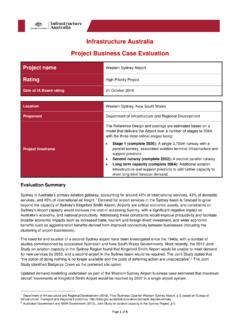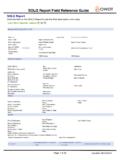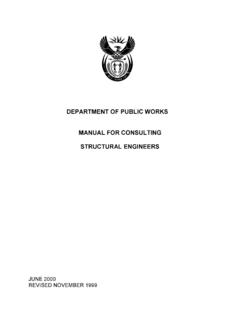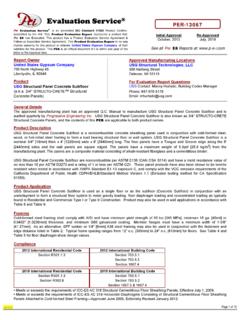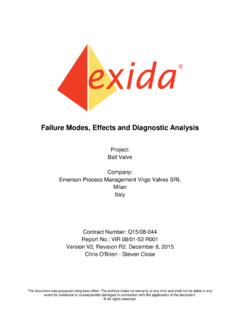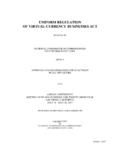Transcription of Report on the 2017 review of the Infrastructure Australia ...
1 Report on the 2017 review of the Infrastructure Australia Assessment Framework 2018 Update 1 Report on the 2017 review of the Infrastructure Australia Assessment Framework 2018 Update final Report 5 March 2018 Report on the 2017 review of the Infrastructure Australia Assessment Framework 2018 Update Report on the 2017 review of the Infrastructure Australia Assessment Framework 2018 Update Contents Glossary i Executive Summary ii Introduction ii Key findings of this review iii 2 Background and Objectives 1 The Infrastructure Australia Assessment Framework (IAAF)
2 1 The process of reviewing the IAAF 2 Scope of work for this review 2 Structure of the Report 3 3 Changes since the January 2016 IAAF 4 4 Findings of the review 7 Documents received 7 Land use impacts 7 Climate change risks 9 Post Completion review 10 5 Our recommendations 12 References 14 Limitation of our work 15 General use restriction 15 Report on the 2017 review of the Infrastructure Australia Assessment Framework 2018 Update i Glossary Acronym Full name ATAP Australian Transport Assessment and Planning BCR Benefit-Cost Ratio CBA Cost Benefit Analysis CSIRO Commonwealth Scientific and Industrial Research Organisation IA Infrastructure Australia IAAF Infrastructure Australia Assessment Framework IPL Infrastructure Priority List NDRRA Natural Disaster Relief and Recovery Arrangements The Act Infrastructure Australia Act 2008 WEBs Wider Economic Benefits Report on the 2017 review of the Infrastructure Australia Assessment Framework 2018 Update ii Executive Summary
3 Introduction The Infrastructure Priority List (IPL) is a list of potential solutions to address nationally significant Infrastructure problems and opportunities. The IPL includes potential Infrastructure solutions at two different stages of development, Initiatives and Projects. In order to be included on the IPL, Initiatives and Projects submissions undergo a rigorous prioritisation process set out by the Infrastructure Australia Assessment Framework (IAAF). The IAAF sets out what proponents must contain in a submission to Infrastructure Australia (IA).
4 A key component of the submission is the inclusion of a cost-benefit analysis (CBA) of the proposed Infrastructure investment. Under the Infrastructure Australia Act 2008 (the Act), IA is required to have the CBA method reviewed every 24 months. This review must consider whether the CBA takes adequately into account social, environmental and economic costs and benefits of Infrastructure proposals. Figure 1 illustrates the reviews of the IAAF undertaken by IA since 2015 to comply with the requirements of the Act.
5 These reviews are reflected in three publications, including the proposed 2018 IAAF as shown in Figure 1. In 2015, IA undertook a review which led to the publication of the February 2016 IAAF. In 2017, IA undertook a review of the IAAF in two stages. The Stage 1 update was completed in the first half of 2017, which led to the publication of the June 2017 IAAF. The Stage 2 update was undertaken in the second half of 2017 and is reflected in the proposed 2018 IAAF. Figure 1 IAAF reviews undertaken since 2015 Deloitte has been commissioned to conduct an independent review of Stages 1 and 2 of the 2017 review by IA (refer to Figure 1), with a focus on the CBA framework and three new sections that have been added to the IAAF or have been significantly enhanced, specifically: Guidance to capture land use impacts into the CBA in D3 Conducting economic appraisals , in particular new guidance provided under Land use impacts.
6 Guidance to account for climate change risks in the IAAF in Considering climate change risks ; and Improved guidance to prepare a Post Completion review in B5 Stage 5: Post Completion review , C7 Checklist for Stage 5: Post Completion review and D5 Undertaking Post Completion Reviews . In addition, the review has assessed the implementation of changes made to the IAAF as part of the Stage 1 update, which led to the publication of the June 2017 IAAF. Report on the 2017 review of the Infrastructure Australia Assessment Framework 2018 Update iii Key findings of this review Previous versions of the IAAF and overall document In relation to the changes that IA has made to the IAAF in the previous revisions (February 2016 and Stage 1 in June 2017) and in response to the recommendations developed in 2015, this review found that the changes have been reflected in these recent updates to the IAAF.
7 In addition, it is worth noting that the overall look and feel of the IAAF has significantly changed since February 2016. The revised IAAF document is more user-friendly and contains relevant technical appendices and updated business case submission templates in the same document. This makes it easier for proponents to follow the submission process and understand IA s requirements. Land use impacts The addition of guidance to measure land use impacts in transport proposals represents a significant change in the conduct of CBAs as currently practised in Australia .
8 The material included in the proposed 2018 IAAF covering land use impacts reflects the issues that would be expected to arise with the measurement of the benefits and costs associated with land use changes. While conducting this review , a number of specific recommendations were made to improve the section on land use impacts, including: Strengthen the additionality and displacement definitions, and outline the resulting uncertainty associated with land use impacts due to these issues; Establish a clearer link between additionality and displacement, and measurement issues, such as land values.
9 And State the difference between the land use impacts in the economic appraisal and the land value capture mechanisms in the financial case. IA has adopted these recommendations within the proposed 2018 IAAF, actioning edits in the relevant sections. The review expects the guidance over the measurement of land use impacts to continue to develop as better spatial data is collected and approaches continue to be refined. Climate change risks The inclusion of climate change risks into the IAAF is a major step forward for Australia , and sets a global benchmark in the treatment of these types of risks within Infrastructure appraisals.
10 The difficulty of including these types of risks within an appraisal framework should not be underestimated, and has been challenging globally. Deloitte has reviewed the new guidance material on climate change within the proposed 2018 IAAF and made the following recommendations: Noting that the interrelationship between Infrastructure and climate change is complex. It is suggested to embed climate change considerations within other parts of the IAAF; Discuss the inclusion of climate change risks, together with other risks and uncertainties, such as development of new technology and economic growth, in the context of general guidance on scenario analysis; and Enhance the guidance on designing and planning resilient Infrastructure .
